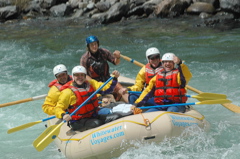By William McGinnis

*****************************
Of course, the best way to cope with flips is to avoid them. You can keep flips to a minimum by working your way up the difficulty scale very gradually, building strong boating skills over time, learning to avoid rocks and holes which could flip your boat, and, in a pinch, skillfully pivoting and high-siding, and squaring-off to big waves and holes.
But as the old saying goes, when it comes to flips, there are two kinds of guides: Those who have and those who will. We should do our very best to avoid flips, but inevitably they will sometimes happen. Here are some things to consider when a flip happens to you:
When you flip:
–Immediately after a flip, count heads. If people are missing, immediately begin a search, first checking any places they could be trapped underwater.
–If it is safe to do so, stay with your boat by grabbing a perimeter line or D-ring (and taking a big breath) just before the flip–then climbing onto the up-side-down bottom. Put loose paddles and other items onto the boat’s bottom. Sometimes, it may be necessary to swim away from an overturned boat to avoid strainers, class VI waterfalls, or other deathtraps.
–Continue to give guidance and reassurance to your crew. Yell: “Keep your feet up!” And, when appropriate, “Swim for the boat!” “Relax, everything’s alright. This is how I always run this rapid.” “OK. Move over here away from the downstream side of the raft.” “Swim with your feet out in front of you. Use your feet to bounce off the rocks.” “Hi. You look so calm and beautiful.”
–Swimmers should not hang out for long on the downstream side of flipped rafts, where they can be crushed between the raft and a rock. Nor should they hang out on the upstream side of the boat, where they cannot see downstream and, if the boat hits a strainer, are liable to be sucked under the raft straight to the strainer. Ideally, right the boat fast and get people back into the right-side-up boat; or, second best, pull swimmers up onto the overturned boat; or, if these alternatives are not possible, have swimmers hang onto the boat where they can see downstream without actually being on the downstream side of the boat.
–Right the boat with your belt flip-line or a bow or stern line passed through a side D-ring. Depending on the situation, this might be done mid-river right away or as soon as the upside down boat is paddled or pulled into an eddy.
–Forgive yourself! It is normal after flipping for a guide to feel rattled and self critical. As quickly as you can, notice how you are feeling, forgive and accept yourself, and focus on how you can learn and grow from the experience. By the way, kind and supportive words from others can really help at times like this!
When someone else flips:
After racing to the rescue of a flipped raft, pulling in swimmers and paddles, and taking the cumbersome, upside-down raft in tow, rescue rafts tend to be extremely heavy and hard to stop. If a long calm or large eddy handily presents itself, great! Or, if the river is not too turbulent, the flipped boat can sometimes be righted in mid-river by pulling on a line attached to the flipped boat’s far side. Often, however, flips occur—and rescues must be performed—when the river is high, fast and rough, when good eddies are scarce, and, perhaps, when the current sweeps through trees on either bank. In this situation, unless there is a compelling reason to stop immediately at all costs, do not power headlong for the bank, where a heavy boat may be driven into the trees, forced along through brush and raked by low branches while its crew grabs futilely at passing tree trunks and clamors in pandemonium. Instead, stay out in mid-current, bide your time, speak calming words to your crew, and wait for a large, catchable eddy to come along. Using a downstream ferry, start very, very early for the eddy, steadily develop more and more momentum, and do your best to pop into the eddy at its uppermost end, punching neatly across the eddy line.
****************
The vital thing in any emergency is that you hang in there, remain outwardly calm (regardless of your true feelings), and try—make some kind of effort—to cope with the situation. This attempt to handle the emergency is the thing—this is what guiding human souls down rivers is all about.
*************************
A pioneer of California rafting, Bill McGinnis founded Whitewater Voyages and teaches internationally renowned guide schools. His books include Whitewater Rafting, The Class V Briefing, River Signals, The Guide’s Guide and most recently The Guide’s Guide Augmented, which presents a comprehensive philosophy and detailed methods for creating “deep fun:” Trips which entertain, inspire, educate, thrill, heal and delight. To learn more about Bill’s books, river trips, and 2-, 5-, & 7-day guide schools, visit WhitewaterVoyages.com or call 800-400-RAFT.

